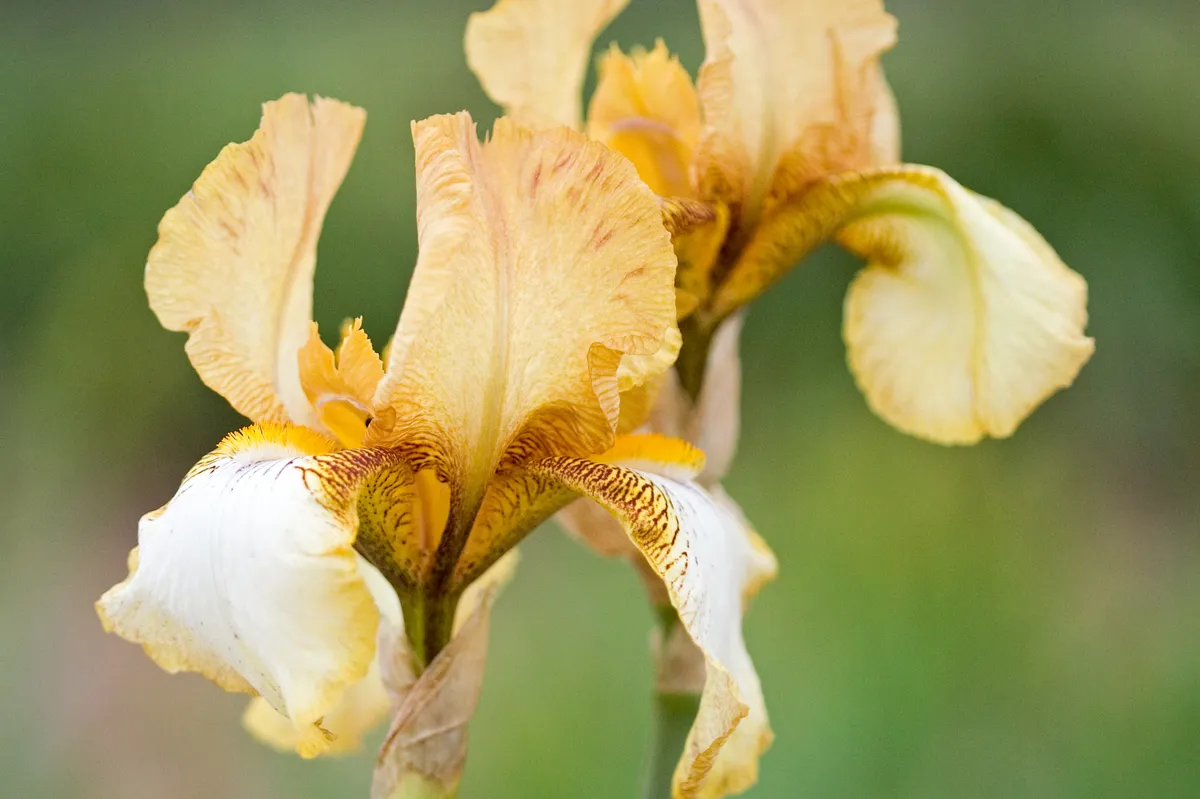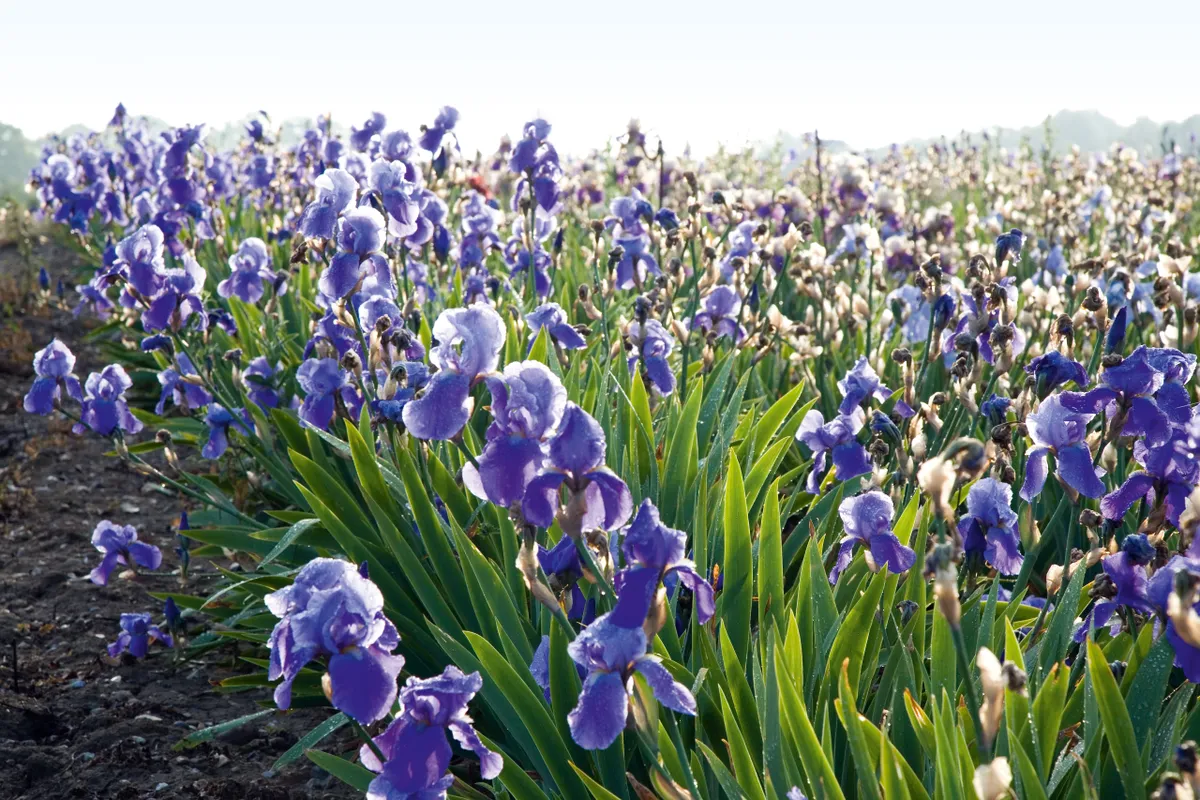The Iris genus comprises approximately 270 species – all of which are native to the Northern Hemisphere. All have six petals, technically called tepals. The three upper petals are known as ‘the standards’ and the three lower as ‘the falls’. Although a number of iris (such as Iris reticulata) are bulbous, most species (including all the bearded) are rhizomatous. Bearded irises are so called from the often decorative beards which sit at the back of each of the falls.

Jump to
- How to care for bearded irises
- When to plant bearded irises
- When to cut back bearded irises
- When and how to divide bearded irises
- Where to plant bearded irises
- The best soil for bearded irises
- Bearded iris diseases
- Where to see and buy bearded irises
- Classic bearded irises to grow
The greatest British bearded iris breeder from this classic period was artist Cedric Morris (1889–1982). I still remember as a child visiting his garden at Benton End near Hadleigh in Suffolk and my first sight of his impeccably elegant iris cultivars. Iris ‘Benton Ankaret’ and Iris ‘Storrington’ both bear witness to his painterly eye; perhaps the RHS should recruit artists as plant breeders.
How to care for bearded irises
When to plant bearded irises
Irises should be planted between July and October, as all their new root development is done in late autumn and early winter. Never transplant bearded irises in spring.
When to cut back bearded irises
Head gardener of the National Trust's Sissinghurst Castle Troy Scott Smith explains how and when to cut back bearded irises after flowering.
When and how to divide bearded irises
Here's Troy Scott Smith's top tips for lifting and dividing bearded irises.
Where to plant bearded irises
Bearded irises need an open position where they can feel the breeze. Poor air circulation, like sticky soil, leads to bacterial problems. To flower well, bearded irises need full sun for at least six hours a day.

The best soil for bearded irises
Bearded irises are easy plants in well-drained soil. They dislike sticky clay soils, which greatly increase the likelihood of bacterial problems. They prefer the soil to be alkaline or neutral. Acid soil should be limed. If the soil is heavy and needs breaking up, dig in quantities of spent mushroom compost or garden compost. Irises do not like excessive nitrogen; never incorporate animal manure into a new bed. Make sure that any preparation work is completed a month before planting, so that the soil can settle.
Bearded iris diseases
Bearded irises are troubled by few pests. Rabbits and caterpillars shun them. Slugs show only a mild interest. The biggest disease problem with bearded irises is fungal leaf spot which in wet seasons can badly affect their foliage. It is best to spray on a preventative basis rather than wait till signs of fungal leaf spot are evident. We spray with a systemic fungicide every three weeks throughout the season – the first application is made when the foliage is about 13cms high.

Bearded irises in brief
What There are around 100,000 cultivars of bearded iris. Origins All derive from species native to the Northern Hemisphere. Season They flower April to June and repeat flowering cultivars again from July to December. Size Height 25cm to 120cm. Conditions Bearded Irises need full sun and well-drained soil, preferably alkine or neutral, as well as a position with good air circulation.

Where to see and buy bearded irises
Woottens of Wenhaston Blackheath Road, Wenhaston, Halesworth, Suffolk IP19 9HD. Tel 01502 478258, www.woottensplants.co.uk
National Collection – Claire Austin Hardy Plants, White Hopton Farm, Wern Lane Sarn, Newtown SY16 4EN. Tel 01686 670342, www.claireaustin-hardyplants.co.uk
Kelways Picts Hill, Langport, Somerset TA10 9EZ. Tel 01458 250521, www.kelways.co.uk
Further reading Irises: a Gardener’s Encyclopedia by Claire Austin (Timber Press,2005)
Classic Irises and the Men and Women Who Created Them by Clarence E Mahan (Krieger Publishing Company, 2006)
The photos here are of pre-1960 cultivars. Under the classification system of the American Iris society, all irises over 20 years old are classified as ‘historics’, a classification that annually increases its scope by another year’s cultivars. I require a less slippery criterion and use the term ‘classic bearded irises’ for all irises introduced before 1960.
Classic bearded irises to grow
Iris ‘Blue rhythm’

A welcome late-flowering cultivar with an abundance of flowers in late June. Introduced in 1945, it is perhaps the truest blue of any iris. Height (H) 100m.
Iris ‘Butterfly dance’

A miniature bearded iris introduced by Dorothy Willott in 2000. This exciting new breeding line is creating plants with the elegance and assurance of classic irises. H 63cm.
Iris ‘Bridesmaid’

A classic plicata that was introduced in 1859. Unlike the over-heavily patterned, modern plicatas, this cultivar demonstrates an airy restraint. H 60cm.
Iris ‘Ozark sky’

Another example of the potential of the modern breeding line of miniature tall bearded irises to replicate the elegance of older classic cultivars. ‘Ozark Sky ‘was introduced by
Kenneth Fisher in 1990. H 56cm.

Iris ‘Brown’s Mutant'

A sport [the term for a variant caused by mutation] of ‘Honorabile’, found in a garden in 1967. It has softer colours than ‘Honorabile’ but preserves its classic form. H 61cm.
Iris 'Pallida'

All tall bearded irises are descended from this one. John Gerard, the 16th-century herbalist, grew it in his Holborn garden and wrote: ‘the flowers to smell exceeding sweete’. H 75cm.
Iris ‘Interpol’

Bred in 1972, this iris was first marketed in Schreiner’s 1981 catalogue. It is just on the tipping point of classic iris turning into modern ruffled bling. H 95cm.
Iris ‘Benton Ankaret’

Thanks to iris collector Sarah Cook, many of Morris’s lost 1950s plicatas [plicatas are white to yellow, veined in a different colour] have been bought back into cultivation. H 100cm.
Iris ‘Storrington’

A very vigorous bitone [different tones of one colour] with a classic form, introduced by Cedric Morris in the 1950s. He much cherished its extended falls. H 107cm.
Iris ‘Glen Ellen’

Introduced by Connell-Williams in 1939, this wonderful luminous yellow is preferable to modern yellow irises which tend to be far too loud with excessive ruffling. H 90cm.
Iris ‘True Charm’

This object lesson in simplicity of form and delicacy of colouring was introduced by Grace Sturtevant in 1920. Modern plicatas are heavier in shape with more lurid markings. H 70cm.
Iris ‘Benton Susan’

A typical, Cedric Morris plicata. Beautifully tailored and restrained. Introduced in 1946. Benton End was the name of Cedric Morris’s house near Hadleigh in Suffolk. H 90cm.
Iris ‘Harbor Blue’

A beautiful early hybrid, introduced in 1954. It displays one of the essential features of a classic iris – the arch formed by the standards, through which light can be seen. H 102cm.
Iris ‘White City’

Introduced in 1939, this is the most perfumed of all white irises, with a perfectly tailored form quite unlike the muddled ruffles of modern cultivars such as ‘Skating Party’. H 90cm.
Iris ‘Cameroun’

Introduced by Ferdinand Cayeux in 1938. This is a fine example of a classic iris, a bitone that has beautiful pink standards and deep wine red falls. H 85m.
Iris ‘El Tovar’

A variegata with great intensity of colour, introduced in 1933 by the great American iris breeder HP Sass, perhaps best remembered as creator of ‘Prairie Sunset’. H 91cm.
Iris ‘Mussolini’

This lovely classic iris has a striking graphic shape. It was introduced in 1932 by the artist Katherine Dykes who was married to William Dykes, a great iris hybridiser. H 100cm.